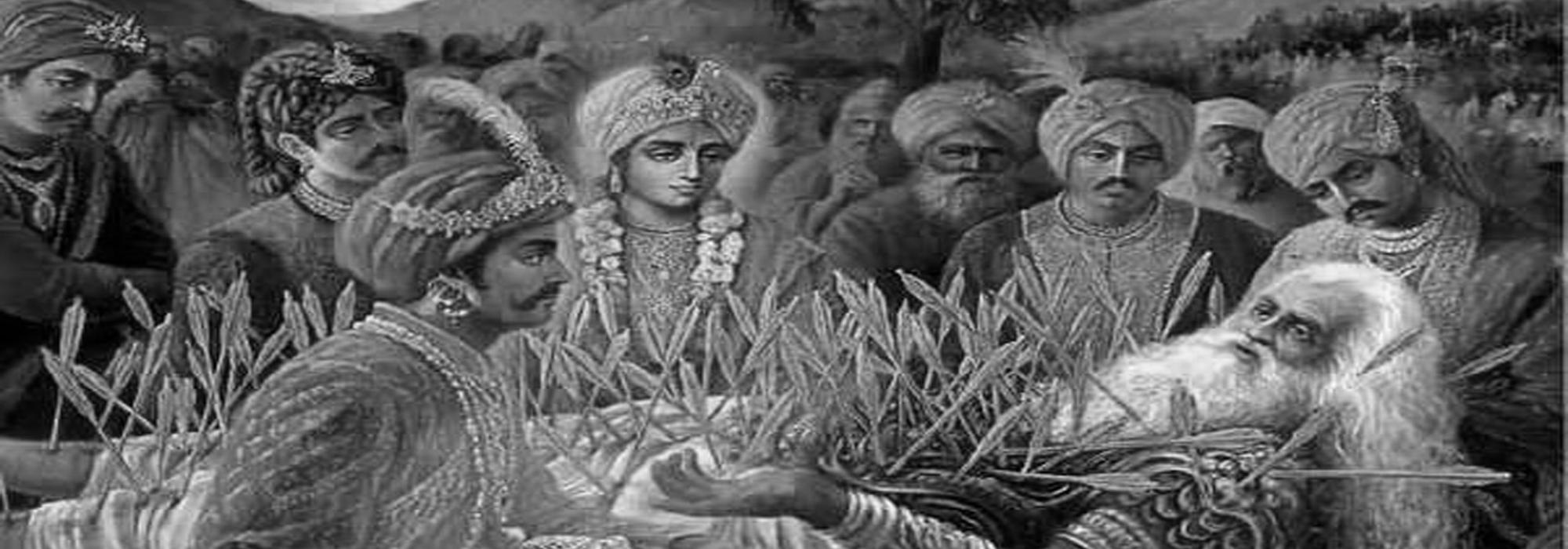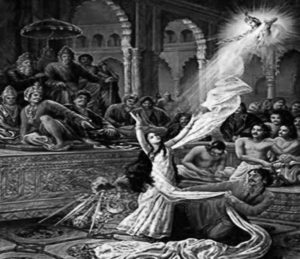There are times when we face difficulties as a result of our own ignorance, indiscretion, dullness of intellect, stupidity, etc., but at other times, we face difficulties because of the ignorance and indiscretion of other people. Sometimes we face difficulties due to reasons beyond us. Thinking this way, we may assume that humans are responsible for wars; however, what can be said of calamities such as earthquakes, cyclone, famine and flood – these are, i.e., acts of the divine.
That said, difficulties and comforts are not in our hands; or, perhaps, a large part of it is unknown to us and lies in the hands of the supreme power that is beyond us. In other words, it perhaps adheres to some principle like dharma or karma, and results in either happiness or difficulty. It is unlikely that these are random events that are not bound by any principles. What is that principle, and is there justice or injustice, partiality or impartiality – who can know? What seems as injustice to our limited senses might be justice in the eyes of the divine. The planets seem to move in irregular orbits, moving further and further away, but in reality, they are not going backward. The crookedness is not in them, but it is in the earth and in its inclination, in its movement, and in our limited perception.
Well, let us assume that it might be so. Perhaps we can assume it to be so but it will be like showing the path towards solution for those who are bereft of comforts, stuck in difficulties and those unable to solve the problems. Does even Brahmā know the answer to this! Can anyone stop the cycle of day and night? Having realised that they are inevitable and bowing down to them, it is only wise to light a lamp in the dark or hold an umbrella in the sun. However, in the absence of oil, if we have to spend a night, or without an umbrella if we have to walk in the sun, it is something we have to experience. It isn’t wise to shout at the darkness or the light, crying our lungs out. It just amounts to punching the air and causing pain to our arms! But then, what to do? Is this not human nature? Yes, but it is only wise for one to identify and correct his weaknesses and ignorance, resulting in as much goodness, peace, and light as possible. The great treatises are primarily for gaining such wisdom. In these works, the great poets have shared their experience and have become great pillars of light to show the way to the common man. In the Mahābhārata, who has not faced difficulty? Who was completely free from sorrow? Starting from Śantanu all the way up to Śrīkṛṣṇa, everyone experienced difficulties.
There is difficulty in the world; it affects all. Everyone has to experience it indeed. ‘Even the deities are not free from difficulties’ – this seems to be the understanding that all characters of the Mahābhārata seem to have had. It was only people like Kṛṣṇa and Kṛṣṇā (Draupadi) who were not only willing to undergo difficulties but also tried to think of ways that would bring them out of misery. They also had the hope that in the future, they would find happiness, after having crossed the hurdles of difficulties. Even so, keeping aside the belief that Mahābhārata is a treatise of dharma, an object of reverence, and a faultless work, when we look at it as a mere story and examine it as a work of literature, it becomes clear right from the beginning: which parts were divinely ordained, which of it was the act of humans, what were the twists of fate and which were the shortcomings of character. It is hard to say what portion of each of these is a direct cause for the sorrows of human beings (i.e. the characters in the epic).
The problems in the Mahābhārata start with Śantanu himself. He is not an ignorant person. The poet of the Mahābhārata has called him a mahātmā, a great soul. Gaṅgā would not have come to him merely by his charming face. And why shouldn’t such a person have got married in the traditional way and managed a family life smoothly? Should he have fallen for a woman on the street—however beautiful, pure in character and respectable she might have been —who imposed so many conditions on the marriage and caused him immense pain which he silently endured? (Let us assume that they got married by gāndharva-vivāha, i.e., marriage with mutual consent, out of love). He had not one, but eight children from her. Of these, she threw seven of them away to their deaths. Matysagandhī (i.e., Satyavatī) and Kunti, who came later, were given more importance.
Śantanu even sent away his beloved one (Gaṅgā) and was satisfied with having a son like Bhīṣma. He probably retained Bhīṣma with him either out of sympathy for the young child or due to his wisdom. Later, his eyes again fell on a girl who belonged neither to his social class nor his royal status! And she was not a virgin; she already had begotten a child! She belonged to a family of fishermen and was called Matysagandhī (literally ‘one who bears the odour of a fish’). If he wished to have her, he had to listen not only to her words but also obey her father’s command; Śantanu did not agree to it. He had at least that much of discernment. Perhaps if Bhīṣma had been adamant at that point, this incident might have ended abruptly (i.e., Śantanu wouldn’t have ended up marrying Matysagandhī). However, it was Bhīṣma’s nature of obedience and respect towards his father that proved to be fatal. He went of his own accord, sacrificed his throne and family life, and brought the girl for his father.
She became his step-mother. He treated her with much more love and care than he treated his own mother. However, their family was never in peace; after begetting two children from her, Śantanu passed away. Of the two sons, one (Citrāṅgada) died in a fight. Bhīṣma procured two girls for the other son (Vicitravīrya) and got them married according to rituals—from that however, let alone annoying hundreds of kings, it proved to be disastrous for one woman (Ambā); she committed suicide. And the other two girls (Ambikā and Ambālikā) were widowed soon. Thus there was no end to the imprudence. Satyavatī thought this over; Bhīṣma gave his consent to her ideas. They procured a person (Vyāsa; Satyavatī’s son from Parāśara) who was leading the life of an ascetic in a far-away place and had him impregnate Vicitravīrya’s widows, who had to agree to the arrangement in spite of their disgust – poor girls, who knows how much they suffered! Among the children who were born to them, one turned to be blind and the other, diseased. Vidura was not their son at all. Yet he was considered as a son of the deceased Vicitravīrya! And the onus of running this family was on Bhīṣma. Although he did not get married, he could not free himself from family responsibilities.
Now, did this get sorted out later on? Since Dhṛtarāṣṭra was blind, Pāṇḍu sat on the throne. Once both had children, the sons of Pāṇḍu claimed their rights over the throne that their father had occupied. The Kauravas (children of Dhṛtarāṣṭra) argued that since their father was the older of the two brothers, the kingdom rightfully belonged to him but due to the defect that he had from birth, it did not—and now, his children should inherit the kingdom. In such a situation who is to solve the problem? If one really quotes the dharma-śāstra and tries to bring justice, would it calm the emotional turmoil? Will it bring peace? Finally it led to another series of injudicious acts; at the end, everything was destroyed. What is the reason for all of this? It seems like the Mahābhārata quotes ‘karma’ as the reason!
To be continued.
Thanks to Śatāvadhāni Dr. R Ganesh for his astute feedback.



















































Comments